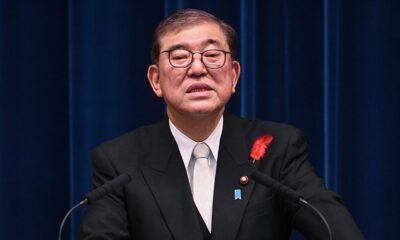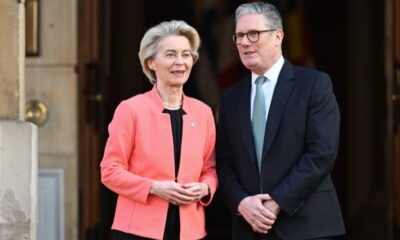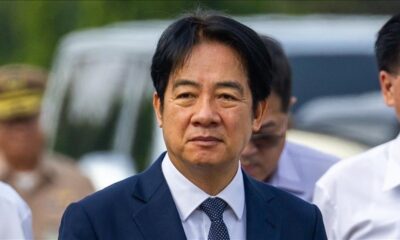Asia
Will the ‘Camp David spirit’ continue after the US elections?

The course of regional crises and conflicts around the world will be determined by the United States presidential elections in November. While the Democrats’ desire to continue with Kamala Harris suggests continuity with the current policies of the Joe Biden era, the course of foreign policy in the event of a victory for the Republican candidate, Donald Trump, is a matter of debate.
Undoubtedly, the Asia-Pacific side of this policy is an important point for US security and foreign policy strategy.
To sum up the situation of the last five years, the US agenda of ‘Indo-Pacific strategy’ has brought the major power balances in the region closer, from an informal alliance against China and North Korea to partnerships with legitimised security agreements and action plans.
On Sunday 28 July, at a fast-track meeting in Tokyo, the US, Japan and South Korea signed agreements to secure gains in security cooperation and strengthen military alliances ahead of a new president in November.
South Korea felt the need to send its defence minister to Tokyo for the talks, his first official visit to the country in 15 years.
What has changed?
In March 2018, a group of senior officials from the South Korean democratic government of Moon Jae-in travelled to Pyongyang for a meeting hosted by North Korean leader Kim Jong-un. At the meeting, Kim announced that he was open to discussing the denuclearisation of the Korean peninsula if the US was willing to provide security guarantees for North Korea’s border security and sovereignty. Following these positive steps, Moon met Kim in Panmunjom on 27 April 2018. Moon and Kim discussed the resumption of the US-China quadrilateral talks and the signing of a peace treaty to formally end the Korean War. They also signed a joint statement calling for ‘complete denuclearisation, a denuclearised Korean Peninsula’. These important diplomatic processes were supported by Trump, and on 12 June 2018, Trump and Kim Jong-un met in Singapore.
Diplomatic efforts with the North stalled in 2019, with high-level talks between Kim and Trump going nowhere. The South Korean opposition stepped up its election efforts, claiming that this approach trampled on national honour. South Korean public opinion was influenced by US Democratic politicians who said that peace on the peninsula was not the way forward. Having made no progress with Pyongyang, Washington decided to abandon its previous policy towards South Korea by demanding that Seoul more than quadruple its financial contribution to the cost of maintaining the US military presence in the country.
In fact, South Korean right-wing conservatives, who believed that peace on the peninsula was not the solution and that ‘Kim and his country must be destroyed’, welcomed the new president, Yoon Seok-yeol, to the White House, where Yoon performed the song ‘American Pie’ with great honour.
Fumio Kishida, who replaced Shinzo Abe, who was assassinated in Japan, reiterated his determination to carry on the ‘hoshu honryu’ traditions and declared that he would continue Abe’s remaining works. The most prominent of these policies was the continuation of steps to change the ‘pacifist defence strategy’, Article 9 of the Japanese Constitution. While Kishida intensified joint agreements with the US Democrats, he also signed rapprochement agreements with the South Korean Yoon government, which is moving in the same direction, in order to satisfy the US.
What are the expectations?
While the race between Harris and Trump is in full swing, Yoon and Kishida appear to be polling poorly in their respective countries. This raises the question of whether a change of leadership in all three countries will continue the ‘Camp David spirit’.
Sources in the region say that the Japanese and South Korean governments have held or are planning dozens of high-level meetings with right-wing think tanks such as the America First Policy Institute, the Heritage Foundation and the Hudson Institute, which are known to be planning policies that Trump could implement in 2025.
When asked for assurances on the matter, Chris LaCivita, a senior adviser to the Trump campaign, said: ‘No one has the authority to make promises on behalf of Donald Trump about continuing a dialogue with another administration’.
Trump’s recent comments on China and North Korea are seen as a signal that he will pursue a more trade-oriented process in the Asia-Pacific. A consortium of conservative think tanks known as ‘Project 2025’, which is making detailed plans for Trump’s second presidency, describes South Korea and Japan as ‘critical allies’ in military, economic, diplomatic and technological terms in Trump scenarios. However, it is unclear how long public support for the South Korean conservatives and Japanese Liberal Democrats in power will last if the Democrats leave the US government.
Asia
Japanese prime minister warns of US tariffs’ impact on global economy
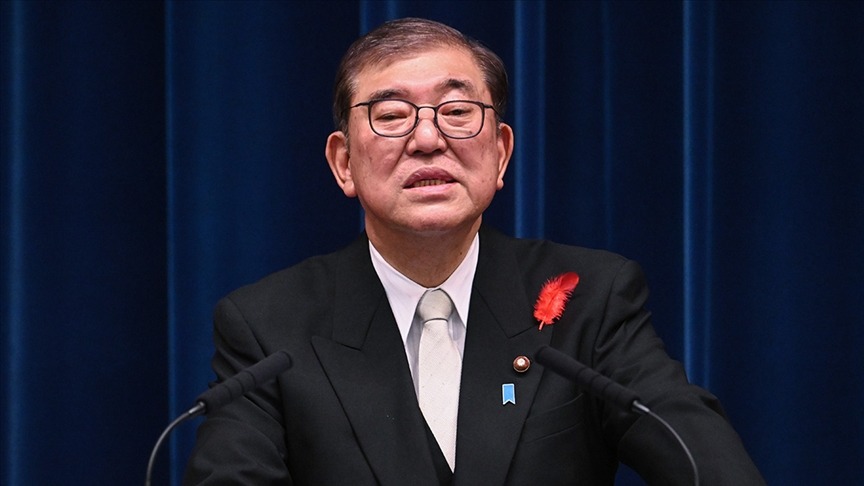
Japanese Prime Minister Shigeru Ishiba warned on Monday that US tariffs could disrupt the global economic order. However, he also emphasized that Japan would seek common ground with the US on how the two countries could cooperate on various issues, from trade to national security.
“When negotiating with the US, we need to understand the logic and emotional elements behind Trump’s views,” Ishiba said in a parliamentary speech.
“I am fully aware that what has happened so far has the potential to disrupt the global economic order,” he said.
Japanese Prime Minister Ishiba also stated that the government is not currently considering issuing a supplementary budget but is ready to take timely action to mitigate the economic impact of US tariffs. Ishiba had previously described Trump’s tariffs as a “national crisis” for Japan. Ishiba stated, “We must call this a national crisis. The government will do everything possible to respond to this crisis affecting the entire country.”
These statements come before the start of bilateral trade talks on Thursday, which are expected to cover various issues, from tariffs and non-tariff barriers to exchange rates.
In his latest statement on tariffs on Sunday, Trump said he would announce the tariff rate to be applied to imported semiconductors within the next week.
Economy Minister Ryosei Akazawa, Japan’s top negotiator in trade talks with the US, said any discussion of exchange rates would take place between Japanese Finance Minister Katsunobu Kato and US Treasury Secretary Scott Bessent.
“Both countries share the view that excessive market volatility will have negative effects on the economy,” Kato said at the same parliamentary session.
Trump’s tariffs are expected to hit the Japanese economy hard. A failed response from Ishiba could become a liability for the prime minister as he leads his party into upper house elections this summer.
Prime Minister Ishiba’s cabinet was already shaky within the LDP and suffering from low approval ratings. His government faces a difficult task, including persuading affected industries within the country to comply with the outcome of negotiations and preparing aid measures.
Asia
Taiwan courts Trump amidst tariff reprieve

When US President Donald Trump stated that he would impose a 32% “reciprocal” tariff on Taiwanese exports, Taiwan’s leader, Lai Ching-te, responded cautiously. With Trump’s decision to delay, a critical 90 days awaits the Lai administration.
Since Trump’s return to the White House in January, Taiwan has made significant efforts to gain favor with Trump and maintain unofficial relations. The largest chip manufacturer, Taiwan Semiconductor Manufacturing Co. (TSMC), has pledged a $100 billion investment in the US, a move supported by Lai. Last month, Taiwan hosted Alaska’s Republican Governor, Mike Dunleavy, a Trump ally, and planned to import liquefied natural gas from the state. The Lai administration has also aligned with US calls for increased defense spending, promising to raise it to 3% of gross domestic product (GDP).
Trump still included Taiwan on his tariff target list. However, his abrupt decision to halt tariffs, except for a 10% baseline rate for everyone, may have opened a “bargaining” window for Taiwan to persuade Trump.
“Now that we have another 90 days, we can discuss Taiwan-US economic and trade cooperation in more detail and depth,” Taiwan’s Foreign Minister, Lin Chia-lung, told reporters on Thursday.
Lin praised the potential collaboration, stating, “We hope to create a joint fleet approach by leveraging the US’s enormous market, excellent technology capital, and talent in a Taiwan-US coalition.”
According to local media, Lai said on Friday that Taiwan was among the “first” on the list for discussions with the Trump administration.
Expressing confidence in Taiwan’s economy in a special broadcast last week, Lai emphasized strengthening industrial cooperation with the US and upgrading Taiwanese industries in global supply chains.
“Taiwan has no plans to adopt retaliatory tariffs to address the US’s reciprocal tariffs. There will be no changes to corporate investment commitments to the US as long as they are consistent with national interests,” Lai stated.
He added, “At the same time, we must ensure that the US clearly understands Taiwan’s contributions to US economic development.”
In an op-ed published by Bloomberg this week, Lai detailed his planned approach. He stated that his administration is willing to reduce its tariffs to zero “on a reciprocal basis with the US.” He also pledged to expand purchases of American goods, continue additional arms purchases, continue making new investments “across the US,” and remove non-tariff barriers while addressing US concerns about export controls and improper transshipment through Taiwan.
“Lai’s approach to foreign relations is cautious and focused primarily on US relations, and secondarily on Japan,” said Rupert Hammond-Chambers, President of the US-Taiwan Business Council.
Hammond-Chambers noted that the sentiment of “deterring China” brings with it the understanding that strong relations with America “must be maintained at all costs.”
In a speech in February, Lai emphasized shared values and expressed gratitude for Trump’s support. Lai pledged to continue reforming and improving defense to encompass “the entire society” and to prioritize special budget allocations to ensure defense spending exceeds 3% of GDP.
The US government has supported Lai’s security reforms, with the de facto American Ambassador, Raymond Greene, openly expressing this support.
TSMC’s $100 billion investment marks the latest in a wave of companies committing large sums to the US: Taiwan and the US are preparing to sign a long-awaited agreement to end double taxation, which will smooth the path.
Hammond-Chambers said that Lai’s approach has so far been well-received among Republican legislators and Trump administration officials.
Asia
Japanese yen hits 7-month high amid trade war fears

The Japanese yen appreciated against the dollar on Friday afternoon, causing the exchange rate to fall below 142. The yen reached its highest level in approximately seven months as the escalating US-China trade war triggered a sell-off of the dollar against other major currencies.
The yen gained nearly 3% against the dollar. Other Asian currencies also strengthened, with the Malaysian ringgit rising 0.72% against the dollar. The South Korean won and the Singapore dollar also appreciated. The euro strengthened against the dollar to levels not seen since February 2022.
Shoki Omori, a global desk strategist at Mizuho Securities, stated, “The yen has risen because there is clearly a risk-off mood in the markets, with Trump imposing larger-than-expected tariffs on China.”
Omori added that recent sell-offs in US Treasury bonds have led investors to move away from the dollar and towards safe-haven assets such as the yen, Swiss franc, and gold. Japan’s large economy, political stability, and liquid financial markets make its currency an attractive safe-haven asset.
US Treasury bonds are traditionally viewed as a low-risk, safe-haven investment. However, the intensifying trade war has increased uncertainty, prompting investors to exit these assets and move into cash.
In the latest escalation of the trade war, China raised its retaliatory tariff rate against the US to 125%. US President Donald Trump had already increased tariffs on China to 145%, even while halting “reciprocal” tariffs on exports from other countries.
The tit-for-tat tariffs caused US stocks to fall sharply on Thursday, while concerns about the economic consequences dampened investor sentiment.
Weakness in US Treasury bonds has played a role in the yen’s strengthening. On Friday morning, the 10-year US Treasury bond yields, a benchmark for long-term interest rates, rose to 4.46% after falling below 4% following Trump’s announcement of new tariffs on trade partners last week. Bond yields move inversely to prices.
The yen typically weakens when US bond yields rise and widen the gap with Japanese bond yields, but strong safe-haven flows have overridden the usual downward pressure on the yen.
Omori from Mizuho predicted that 10-year US Treasury bond yields would fall as the year progresses. Omori estimates that the Federal Reserve will cut interest rates at least two to three times, depending on the health of the US economy.
He stated that a downturn in the US economy would mean lower yields on 10-year Japanese government bonds. “Of course, we may experience shocks depending on what happens in the US, and we must not forget that the Japanese government may issue more bonds for fiscal policy,” he said.
The yen’s appreciation dragged down the share prices of Japanese exporters on Friday. Shares of Nissan Motor closed down 6%, while shares of Toyota Motor fell 5%. Technology stocks such as Furukawa Electric lost around 6% in value.
-

 America6 days ago
America6 days agoThe economic mind of Trumpism — 1: Stephen Miran and his dollar devaluation plan
-

 Middle East2 weeks ago
Middle East2 weeks agoIsrael bombs Syrian base T4, reportedly warning Türkiye against military presence
-
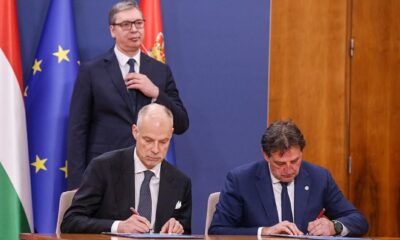
 Europe2 weeks ago
Europe2 weeks agoSerbia and Hungary sign comprehensive military cooperation agreement
-

 Diplomacy2 weeks ago
Diplomacy2 weeks agoMeta fined significantly in Türkiye for defying content removal orders
-

 America6 days ago
America6 days agoUS considers delisting Chinese stocks amid trade tensions
-
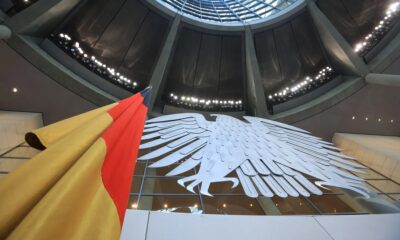
 Diplomacy7 days ago
Diplomacy7 days agoTrump’s tariffs boost interest in German, Japanese bonds
-

 Europe2 weeks ago
Europe2 weeks agoEuropean right gathers at Israeli government event on antisemitism
-
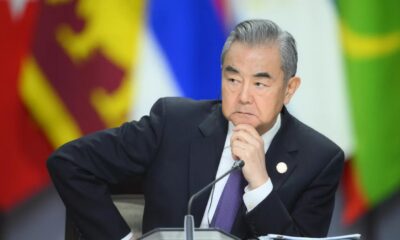
 Diplomacy2 weeks ago
Diplomacy2 weeks agoUS harms its own reputation with trade wars, Wang Yi says








